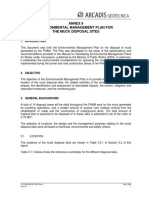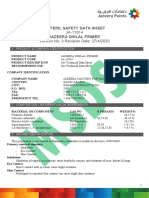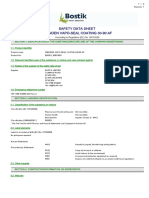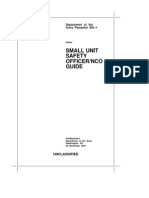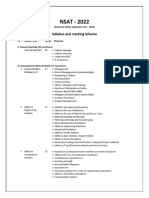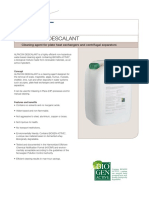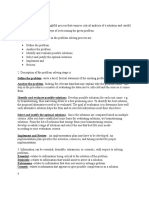DM-PH&SD-P4-TG13 - (Guidelines For Personal Protective Equipment-Foot Protection) PDF
DM-PH&SD-P4-TG13 - (Guidelines For Personal Protective Equipment-Foot Protection) PDF
Uploaded by
demie figueroaCopyright:
Available Formats
DM-PH&SD-P4-TG13 - (Guidelines For Personal Protective Equipment-Foot Protection) PDF
DM-PH&SD-P4-TG13 - (Guidelines For Personal Protective Equipment-Foot Protection) PDF
Uploaded by
demie figueroaOriginal Title
Copyright
Available Formats
Share this document
Did you find this document useful?
Is this content inappropriate?
Copyright:
Available Formats
DM-PH&SD-P4-TG13 - (Guidelines For Personal Protective Equipment-Foot Protection) PDF
DM-PH&SD-P4-TG13 - (Guidelines For Personal Protective Equipment-Foot Protection) PDF
Uploaded by
demie figueroaCopyright:
Available Formats
Organization Unit Public Health & Safety Department
Guidelines for Personal Protective Equipment –
Form sheet title:
Foot Protection
Doc Ref. DM-PH&SD-P4-TG13
Background: Protective footwear must protect against hazards ranging from
contact with chemicals, extremes of cold and heat, slippery
surfaces, punctures from nails and other sharp objects, electrical
hazards, molten metal and impact in an industrial operation. It is
necessary to assess the hazard or combination of hazards and
select the items of protection. Every employer shall provide
suitable safety footwear for the type of operation performed.
Every employee shall wear safety footwear while working in the
workplace, to protect against foot injuries. Dubai Local Order
No. 61 of 1991 requires the provision of protective devices by
the employer and the use of this equipment by the employees.
Guidelines:
1. Where there is no potential risk of physical injury, but possibility of other
associated risks such as chemical spills etc., the employee should wear
shoes to protect his feet, The use of slip-on or sandals or chapels are not
acceptable as workplace footwear.
2. Safety shoes or boots are required to be worn by all workers engaged in
any workplace such as construction, quarry, mines, industry, workshop,
laundry and in other places where there is potential hazard of foot injury.
3. Safety shoes and boots with steel toe caps should provide protection from
various degrees of impact. The protection is essentially to protect the toes.
Instep and shin protection may also be necessary in high risk areas.
4. The protection against cuts and punctures from sharp objects such as
nails, scrap metals, glass may be obtained by the use of steel shoe inserts
(steel mid-sole) which should be rubberized to prevent rusting and
excessive movement.
5. Contact with chemicals, will cause leather to crack and also result in
injury due to absorption of the chemical. Plastic and synthetic rubber e.g.
Neoprene, sole and uppers made from synthetic materials are more
resistant to chemicals.
5/1:الصفحة 2010 أبريل:تاريخ اإلصدار 2 : رقم اإلصدار
Organization Unit Public Health & Safety Department
Guidelines for Personal Protective Equipment –
Form sheet title:
Foot Protection
Doc Ref. DM-PH&SD-P4-TG13
6. For hot floor temperatures, heat resistant soles such as expanded
polyurethane, wooden soles and foundry shoes are suitable. Ankle boots,
spats and leggings should be used when there is a risk of hot materials.
e.g. bitumen or cinders, entering over the top of shoes. Foundry shoes and
leggings are designed permit the wearer to remove them quickly should
molten metal penetrate.
7. For wet and muddy conditions, rubber, neoprene or plastic boots and
overshoes either with or without steel toe caps and in-soles should be
used. Leg length ranges from ankle boots and shin length, to knee and
thigh length should be selected depending upon the need.
8. The buildup static electricity on the person may be reduced by the use of
specially selected electrically conductive footwear. This is only suitable
for use in areas where the risk of electric shock from any electrical
apparatus has been completely eliminated.
9. Where live electrical current above 250 volts is the hazard, non-
conductive safety footwear free from nails, metal eyelet must be used. It
must be sewn or bonded construction.
10. Table -1 should be used a guide in the selection of safety shoes and boots
for certain operations. Where there is doubt about design and component
problems, it is advisable to contact the manufacturers and then make
comparisons for suitability.
11. Further References:
British Standard Specification
BS - 1870 Safety footwear
BS - 2050 Electrical resistance of conductive and anti-static products
BS - 2506 Anti-static rubber footwear
BS - 5451 Anti-static footwear standards
BS - 3825 Electrically conducting rubber footwear
BS - 4696 Gaiters and footwear for protection against burns and
impact risks in foundries.
5/2:الصفحة 2010 أبريل:تاريخ اإلصدار 2 : رقم اإلصدار
Organization Unit Public Health & Safety Department
Guidelines for Personal Protective Equipment –
Form sheet title:
Foot Protection
Doc Ref. DM-PH&SD-P4-TG13
BS - 953 Steel caps
American Standard Specification
ANSI Z 41.1 Men’s Safety - Toe Footwear
En Standards Specification
FURTHER INFORMATION IS AVAILABLE FROM
PUBLIC HEALTH AND SAFETY DEPARTMENT
Tel: 2064244 FAX: 2270160
5/3:الصفحة 2010 أبريل:تاريخ اإلصدار 2 : رقم اإلصدار
Organization Unit Public Health & Safety Department
Guidelines for Personal Protective Equipment –
Form sheet title:
Foot Protection
Doc Ref. DM-PH&SD-P4-TG13
TABLE 1
a b c d e f g h i j k l mn o p q r s t
BOOTS AND SHOES
= SUITABLE
Suitable for -
Bitumen spraying
Boiler/furnace operations
Cleaning - high pressure water jets
Construction Work- general
Crane operations
Production operations
Electric welding
Electrical work- general
Engineering Workshops
Erection Work
Filling cylinders - LPG
Filling drums - chemicals (Note -1)
Filling drums - oil products
Filling gantries - Chemicals (Note-1)
Fire - fighting
Gas welding /cutting
General purposes
Handling bags
Handling /blending chemicals (Note-1)
Handling cryogenic materials
Handling drums
Handling scrap metal
Handling tins
Handling tinplate, glass etc.
Handling wet/greasy materials
Heavy manual work
Laboratories - general
a. Knee boots , rubber b.
c. Ankle boots, rubber d. Thigh boots, rubber
e. f. Leather boots, leather
g. Leather boots, rubber soles h. Leather boots, moulded soles
i. Leather shoes, leather soles j. Leather shoes, rubber soles
k. Leather shoes, moulded soles l. Overshoes, rubber (up to 650 v)
m. Instep guards n.
o. Footwear, semi-conductive (Note 2) p. Over shoes poly-disposable
q. r.
s. t.
5/4:الصفحة 2010 أبريل:تاريخ اإلصدار 2 : رقم اإلصدار
Organization Unit Public Health & Safety Department
Guidelines for Personal Protective Equipment –
Form sheet title:
Foot Protection
Doc Ref. DM-PH&SD-P4-TG13
TABLE 1 (Continued)
a b c d e f g h i j k l mn o p q r s t
BOOTS AND SHOES
= SUITABLE
Suitable for -
Metal spraying
Radiation heat
Slippery surfaces
Slush/oil covered surfaces
Spillages, chemical -clean up (note-1)
Spillages, oil - clean up
Steam cleaning
Tank/vessel cleaning:
- Chemicals
- Leaded gasoline
- Crude / other products
- Tank dipping / sampling
Tin factories
a. Knee boots , rubber b.
c. Ankle boots, rubber d. Thigh boots, rubber
e. f. Leather boots, leather
g. Leather boots, rubber soles h. Leather boots, moulded soles
i. Leather shoes, leather soles j. Leather shoes, rubber soles
k. Leather shoes, moulded soles l. Overshoes, rubber (up to 650 v)
m. Instep guards n.
o. Footwear, semi-conductive (Note 2) p. Over shoes poly-disposable
q. r.
s. t.
Note 1: Natural rubber is not suitable for aromatic hydrocarbons
Note 2: Semi -conductive footwear should only be used when:
i. Conductivity is checked regularly
ii. The floor is sufficiently conductive and is earthed.
5/5:الصفحة 2010 أبريل:تاريخ اإلصدار 2 : رقم اإلصدار
You might also like
- Breeder Signals, A Practical Guide To Optimal Management of Broiler Breeders (VetBooks - Ir)Document190 pagesBreeder Signals, A Practical Guide To Optimal Management of Broiler Breeders (VetBooks - Ir)Tata EmongNo ratings yet
- Plywood Material Safety Data Sheet For MR Plywood PDFDocument4 pagesPlywood Material Safety Data Sheet For MR Plywood PDFNirvana NircisNo ratings yet
- DM PHSD P7 TG6 Emergency+Preparedness+GuidelineEN1 PDFDocument10 pagesDM PHSD P7 TG6 Emergency+Preparedness+GuidelineEN1 PDFdemie figueroaNo ratings yet
- Instruction Manual EA 3600 7200 10800 English 103Document148 pagesInstruction Manual EA 3600 7200 10800 English 103Stephany Sucerquia100% (2)
- Chemical Segregation Table 230302 123808Document6 pagesChemical Segregation Table 230302 123808Zaira AsorNo ratings yet
- ENG - DM-PHSD-P6-WI-02 Health Requirements For Labor Accommodation PDFDocument7 pagesENG - DM-PHSD-P6-WI-02 Health Requirements For Labor Accommodation PDFdemie figueroaNo ratings yet
- SDS Bengalac Gloss AlmondDocument10 pagesSDS Bengalac Gloss AlmondSreejith MadhavanNo ratings yet
- Safety Data Sheet: Nitobond Pva15Document3 pagesSafety Data Sheet: Nitobond Pva15adil khan100% (1)
- Development of Emergency Response Procedure For Accidents Involving Dangerous GoodsDocument5 pagesDevelopment of Emergency Response Procedure For Accidents Involving Dangerous GoodsMuhammad Faheem100% (1)
- MNL 71-2014 PDFDocument80 pagesMNL 71-2014 PDFloloNo ratings yet
- DM-PH&SD-P4-TG14 - (Guidelines For Personal Protective Equipment-Fall Protection-Safety Lines) PDFDocument3 pagesDM-PH&SD-P4-TG14 - (Guidelines For Personal Protective Equipment-Fall Protection-Safety Lines) PDFdemie figueroaNo ratings yet
- DM-PH&SD-P4-TG04 - (Guidelines For Entry Into Confined Spaces) PDFDocument3 pagesDM-PH&SD-P4-TG04 - (Guidelines For Entry Into Confined Spaces) PDFdemie figueroa100% (1)
- DM-PH&SD-P4-TG06 - (Guidelines For Guarding of Dangerous Machinery) PDFDocument7 pagesDM-PH&SD-P4-TG06 - (Guidelines For Guarding of Dangerous Machinery) PDFdemie figueroaNo ratings yet
- StudentDocument45 pagesStudentJoel Christian MascariñaNo ratings yet
- DM-PH&SD-P4-TG08 - (Guidelines For Personal Protective Equipment-Head Protection)Document3 pagesDM-PH&SD-P4-TG08 - (Guidelines For Personal Protective Equipment-Head Protection)narma143No ratings yet
- DM-PH&SD-P4-TG09 - (Guidelines For Personal Protective Equipment-Eye and Face Protection) PDFDocument7 pagesDM-PH&SD-P4-TG09 - (Guidelines For Personal Protective Equipment-Eye and Face Protection) PDFdemie figueroaNo ratings yet
- DM-PH&SD-P4-TG11 - (Guidelines For Personal Protective Equipment-Protective Clothing) PDFDocument4 pagesDM-PH&SD-P4-TG11 - (Guidelines For Personal Protective Equipment-Protective Clothing) PDFdemie figueroaNo ratings yet
- DM-PH&SD-P4-TG12 (Guidelines For Personal Protective Equipment-Hand Protection) PDFDocument5 pagesDM-PH&SD-P4-TG12 (Guidelines For Personal Protective Equipment-Hand Protection) PDFdemie figueroaNo ratings yet
- DM-PH&SD-P4-TG10 - (Guidelines For Personal Protective Equipment-Hearing Protection) PDFDocument3 pagesDM-PH&SD-P4-TG10 - (Guidelines For Personal Protective Equipment-Hearing Protection) PDFdemie figueroaNo ratings yet
- DM-PH&SD-P4-TG15 - (Guidelines For Personal Protective Equipment-Respiratory Protection) PDFDocument9 pagesDM-PH&SD-P4-TG15 - (Guidelines For Personal Protective Equipment-Respiratory Protection) PDFdemie figueroaNo ratings yet
- DM-PH&SD-P4-TG16 - (Guidelines For Safe Use of Industrial Organic Solvents)Document8 pagesDM-PH&SD-P4-TG16 - (Guidelines For Safe Use of Industrial Organic Solvents)narma143No ratings yet
- Risk Analysis of BMSDocument4 pagesRisk Analysis of BMSWinnie RaghuNo ratings yet
- Annex 06 - Disposal Materials PlanDocument23 pagesAnnex 06 - Disposal Materials Planchetan khandelwalNo ratings yet
- Review Hazard Hunt WGG PDFDocument3 pagesReview Hazard Hunt WGG PDFNor HaiqhalNo ratings yet
- MSDS Nalco@N7330Document12 pagesMSDS Nalco@N7330wangwhzjcnNo ratings yet
- ISGEC Heavy Engineering Limited: Checklist For Equipment InspectionDocument43 pagesISGEC Heavy Engineering Limited: Checklist For Equipment Inspectionallu arunNo ratings yet
- Gloves MatrixDocument1 pageGloves MatrixkhaledhfmNo ratings yet
- Hazardous Materials PPEDocument89 pagesHazardous Materials PPESUNNYWAY CONSTRUCTIONNo ratings yet
- SDS - Bengalac Red Oxide Primer - English (Uk) - DubaiDocument5 pagesSDS - Bengalac Red Oxide Primer - English (Uk) - DubaiBalasubramanian Ananth100% (1)
- PPE Policy 2Document6 pagesPPE Policy 2Jay arNo ratings yet
- HSE Instruction To Contractors-HPCLDocument8 pagesHSE Instruction To Contractors-HPCLrome_n21No ratings yet
- Cleaning: Inspection and Maintenance Checklist For Fall Arrest SystemsDocument3 pagesCleaning: Inspection and Maintenance Checklist For Fall Arrest Systemsal mubarokNo ratings yet
- List of Select Indian Standards On SafetDocument12 pagesList of Select Indian Standards On SafetloganathanNo ratings yet
- Jazeera Dhilal Primer-MsdsDocument5 pagesJazeera Dhilal Primer-MsdsMahmoud Flefil100% (1)
- Risk Assessments - Indoor TrainingDocument12 pagesRisk Assessments - Indoor TrainingVasile NodisNo ratings yet
- Delivery of ConcreteDocument5 pagesDelivery of Concretesikandar1234No ratings yet
- CNG COCO Station TenderDocument378 pagesCNG COCO Station TenderArunkumar SelvamNo ratings yet
- DM-PH&SD-P4-TG23 - (Guidelines For Safety Procedures in Metal Finishing Industries) PDFDocument3 pagesDM-PH&SD-P4-TG23 - (Guidelines For Safety Procedures in Metal Finishing Industries) PDFdemie figueroaNo ratings yet
- IFP Net 3+Applications+WebinarDocument21 pagesIFP Net 3+Applications+WebinarcanchapaxiNo ratings yet
- MSDS Rust-Remover-SDS5048Document7 pagesMSDS Rust-Remover-SDS5048nikoNo ratings yet
- Principles and Guidelines For Installation or Modification of Traffic SignalsDocument14 pagesPrinciples and Guidelines For Installation or Modification of Traffic SignalsjeremiahNo ratings yet
- Ji 2027 Jsa 050 Grouting Work PDF FreeDocument2 pagesJi 2027 Jsa 050 Grouting Work PDF FreeBinayNo ratings yet
- WmoguidelinesDocument34 pagesWmoguidelinesSarthak SouravNo ratings yet
- Safety Footwear Assessment Procedure FormDocument7 pagesSafety Footwear Assessment Procedure FormKhalid NaseemNo ratings yet
- Dac - Floor CleanerDocument10 pagesDac - Floor CleanerGopakumar KPNo ratings yet
- DM HSD GU97 PPEFP2 - Technical Guideline On PPE Foot ProtectionDocument17 pagesDM HSD GU97 PPEFP2 - Technical Guideline On PPE Foot ProtectionNatalie Blackmore100% (1)
- ARDROX 8530 Black Mag InkDocument11 pagesARDROX 8530 Black Mag InkAdamNo ratings yet
- National Guard Epoxy Red Oxide PrimerDocument3 pagesNational Guard Epoxy Red Oxide PrimerCyril J PadiyathNo ratings yet
- MS On Site Clearing and GrubbingDocument7 pagesMS On Site Clearing and GrubbingBunny RafaelNo ratings yet
- SOP SOP0003 Nail GunDocument2 pagesSOP SOP0003 Nail Gunjeevan georgeNo ratings yet
- A Brief Guide To The European Standards For Eye Protection - EN166Document2 pagesA Brief Guide To The European Standards For Eye Protection - EN166Every Thing100% (1)
- 1.ooreedoo - RA For Maintenance of Chillers. RevisedDocument6 pages1.ooreedoo - RA For Maintenance of Chillers. RevisedstarwingsNo ratings yet
- Avikote AV 800-7Document2 pagesAvikote AV 800-7Amer Y KNo ratings yet
- Sikadur-31CF PART A MSDSDocument13 pagesSikadur-31CF PART A MSDSebenezer EsemuruNo ratings yet
- 5600 Turbomaster XD 15W 40 CI 4Document3 pages5600 Turbomaster XD 15W 40 CI 4elnhhas720% (1)
- MSDSDocument6 pagesMSDSbuddhikasat0% (1)
- Oxygen MSDS-Bristol GasesDocument5 pagesOxygen MSDS-Bristol GasesAhmad Talaat100% (1)
- Da Pam 385-40 - Accident Investigation & ReportingDocument53 pagesDa Pam 385-40 - Accident Investigation & ReportingMark CheneyNo ratings yet
- NSAT 2022: Syllabus and Marking SchemeDocument3 pagesNSAT 2022: Syllabus and Marking SchemeAmit SinghNo ratings yet
- 2 NP 2Document6 pages2 NP 2Melati Nurul Utami100% (1)
- Ansi A10.14 - 1975Document14 pagesAnsi A10.14 - 1975Cristian SnchezNo ratings yet
- Alpacon Descalant: Cleaning Agent For Plate Heat Exchangers and Centrifugal SeparatorsDocument2 pagesAlpacon Descalant: Cleaning Agent For Plate Heat Exchangers and Centrifugal SeparatorsSubramanian gokulNo ratings yet
- Biology and Chemistry PPE MatrixDocument5 pagesBiology and Chemistry PPE MatrixAswin ReddigaruNo ratings yet
- LPG Gas Leakage Detection and Alert SystemDocument6 pagesLPG Gas Leakage Detection and Alert SystemIJRASETPublicationsNo ratings yet
- Tool For Assessing The Implementation of IOGP Report 365Document13 pagesTool For Assessing The Implementation of IOGP Report 365Muhammad MuhammadNo ratings yet
- Foot Wear StandardsDocument12 pagesFoot Wear StandardsNabil Al-afifiNo ratings yet
- Astm F 2412Document15 pagesAstm F 2412Jorge MartelNo ratings yet
- Workplace Vocabulary for Esl Students: With Exercises and TestsFrom EverandWorkplace Vocabulary for Esl Students: With Exercises and TestsNo ratings yet
- DM-PH&SD-P4-TG23 - (Guidelines For Safety Procedures in Metal Finishing Industries) PDFDocument3 pagesDM-PH&SD-P4-TG23 - (Guidelines For Safety Procedures in Metal Finishing Industries) PDFdemie figueroaNo ratings yet
- Dubai Municipality Codes ListDocument8 pagesDubai Municipality Codes Listdemie figueroaNo ratings yet
- DM PH&SD P4 TG22 (Guidelines+for+Acetylene+Generators) PDFDocument2 pagesDM PH&SD P4 TG22 (Guidelines+for+Acetylene+Generators) PDFdemie figueroaNo ratings yet
- DM-PHSD-P7-A-TG - (Guidelines For Rope Access Work) English PDFDocument11 pagesDM-PHSD-P7-A-TG - (Guidelines For Rope Access Work) English PDFdemie figueroaNo ratings yet
- DM-PH&SD-P4-TG21 - (Guidelines For Examination and Certification of Cranes, Hoists, Lifts and Other Lifting Appliances) PDFDocument2 pagesDM-PH&SD-P4-TG21 - (Guidelines For Examination and Certification of Cranes, Hoists, Lifts and Other Lifting Appliances) PDFdemie figueroaNo ratings yet
- DM-PH&SD-P4-TG18 - (Guidelines For Safety in Vehicle Repair and Servicing Shops) PDFDocument6 pagesDM-PH&SD-P4-TG18 - (Guidelines For Safety in Vehicle Repair and Servicing Shops) PDFdemie figueroaNo ratings yet
- DM-PH&SD-P4-TG15 - (Guidelines For Personal Protective Equipment-Respiratory Protection) PDFDocument9 pagesDM-PH&SD-P4-TG15 - (Guidelines For Personal Protective Equipment-Respiratory Protection) PDFdemie figueroaNo ratings yet
- DM-PH&SD-P7-WI18 - (Health Requirements For The Services Provided Inside Labours Accommodations) PDFDocument4 pagesDM-PH&SD-P7-WI18 - (Health Requirements For The Services Provided Inside Labours Accommodations) PDFdemie figueroaNo ratings yet
- CYbersecDocument19 pagesCYbersecBloodLetterNo ratings yet
- Beowulf Plot SummaryDocument46 pagesBeowulf Plot SummaryMaría AlejandraNo ratings yet
- How To Fold A Zine Thankubody USLetterSizeDocument1 pageHow To Fold A Zine Thankubody USLetterSizeJuan AcostaNo ratings yet
- Module 3 Note1Document2 pagesModule 3 Note1JamieNo ratings yet
- Department of Education: Parental Consent FormDocument3 pagesDepartment of Education: Parental Consent FormSarah Janine EsguerraNo ratings yet
- (M2S2-POWERPOINT) Control Self-Assessment (CSA) and Evaluating The Internal Audit ActivityDocument18 pages(M2S2-POWERPOINT) Control Self-Assessment (CSA) and Evaluating The Internal Audit ActivityJayson J. ManlangitNo ratings yet
- Nufanbalafif, Journal Manager, 4) EDUNursing V2N2 September 2020 87-92Document6 pagesNufanbalafif, Journal Manager, 4) EDUNursing V2N2 September 2020 87-92Melda WatiNo ratings yet
- Efficient Designs of Multiported Memory On FPGA: Bo-Cheng Charles Lai, Member, IEEE, and Jiun-Liang LinDocument12 pagesEfficient Designs of Multiported Memory On FPGA: Bo-Cheng Charles Lai, Member, IEEE, and Jiun-Liang LinManjunath BadigerNo ratings yet
- 320movie Blockbusters 1st Edition Julian Stringer All Chapter Instant DownloadDocument84 pages320movie Blockbusters 1st Edition Julian Stringer All Chapter Instant Downloadtabanimwenyo100% (7)
- My Childhood Nandor MălăceaDocument1 pageMy Childhood Nandor MălăceahrisantisNo ratings yet
- Ip060-45!20!02 Orifice Plate Assembly (Buyer's Scope)Document5 pagesIp060-45!20!02 Orifice Plate Assembly (Buyer's Scope)Rahul DevaNo ratings yet
- Kerangka KonsepDocument1 pageKerangka KonsepaishaysNo ratings yet
- Thesis Topics in Paediatric NeurologyDocument5 pagesThesis Topics in Paediatric Neurologyydpsvbgld100% (2)
- Budgeting and Overhead Cost AllocationDocument31 pagesBudgeting and Overhead Cost AllocationJatin AroraNo ratings yet
- Philippine and World Literature Cathleen 1Document75 pagesPhilippine and World Literature Cathleen 1Bob FloresNo ratings yet
- Social Problems Syllabus Fall-2010Document15 pagesSocial Problems Syllabus Fall-2010Kathryn BufordNo ratings yet
- 1z0-931.prepaway - Premium.exam.60q: Number: 1z0-931 Passing Score: 800 Time Limit: 120 Min File Version: 1.0Document21 pages1z0-931.prepaway - Premium.exam.60q: Number: 1z0-931 Passing Score: 800 Time Limit: 120 Min File Version: 1.0Rajdeep Dash SojibNo ratings yet
- 070 - 1235 - Dewi Purnamasari - GalleyDocument6 pages070 - 1235 - Dewi Purnamasari - Galley2pr6ztzzbwNo ratings yet
- AnswerSheet AssignmentDocument3 pagesAnswerSheet AssignmentMirian AriasNo ratings yet
- How To Apply For IPO Through ASBADocument27 pagesHow To Apply For IPO Through ASBANirav DesaiNo ratings yet
- Computation Mumbai Bazaar 2022Document3 pagesComputation Mumbai Bazaar 2022Sanjeev RanjanNo ratings yet
- Plaintiff-Appellee Accused-Appellant: People of The Philippines, Aubrey Enriquez SoriaDocument11 pagesPlaintiff-Appellee Accused-Appellant: People of The Philippines, Aubrey Enriquez SoriaDarla EnriquezNo ratings yet
- Cryofuge 6000i 8500i User Manual PDFDocument54 pagesCryofuge 6000i 8500i User Manual PDFRajeesh P Ravi100% (1)
- Week 2Document24 pagesWeek 27x6t2v4j6xNo ratings yet
- Backyard Earthworms 2014 VMDocument40 pagesBackyard Earthworms 2014 VMtapansNo ratings yet
- Attahu 2022 IOP Conf. Ser. Mater. Sci. Eng. 1225 012005Document12 pagesAttahu 2022 IOP Conf. Ser. Mater. Sci. Eng. 1225 012005Ivan LingNo ratings yet
- CH 10Document49 pagesCH 10qais0883No ratings yet






















